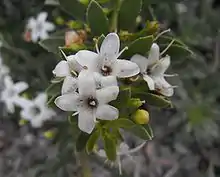Myoporum parvifolium
Myoporum parvifolium, commonly known as creeping boobialla, creeping myoporum, dwarf native myrtle or small leaved myoporum[1] is a plant in the figwort family, Scrophulariaceae. It is a low, spreading shrub with long, trailing stems and white, star-shaped flowers and is endemic to southern Australia including Flinders Island.
| Creeping boobialla | |
|---|---|
 | |
| Myoporum parvifolium at San Diego Botanic Garden | |
| Scientific classification | |
| Kingdom: | Plantae |
| Clade: | Tracheophytes |
| Clade: | Angiosperms |
| Clade: | Eudicots |
| Clade: | Asterids |
| Order: | Lamiales |
| Family: | Scrophulariaceae |
| Genus: | Myoporum |
| Species: | M. parvifolium |
| Binomial name | |
| Myoporum parvifolium | |
| Synonyms | |
| |
Description
Creeping boobialla is a prostrate, spreading shrub sometimes forming a mat 3 metres (10 ft) in diameter. Its leaves are fleshy and glabrous, usually 18–40 millimetres (0.7–2 in) long, 3–6.5 millimetres (0.1–0.3 in) wide and egg-shaped with the narrower end towards the base. They are arranged alternately, sometimes have a few serrations on the margins near the leaf tip and sometimes have raised, wart-like tubercles on their surface.[2][3][4][5]
White flowers with purple spots appear in the leaf axils singly or in clusters of 2 or 3 on a stalk 7.5–33 millimetres (0.3–1 in) long. The flowers have 5 lance-shaped sepals and 5 petals joined at their bases to form a tube. The tube is about 3 millimetres (0.1 in) long and the lobes are spreading, blunt and 3–4 millimetres (0.1–0.2 in) long. As a result, the diameter of the flower is about 7.5 millimetres (0.3 in). There are 4 stamens which extend beyond the petals. Peak flowering times are winter to summer in New South Wales and October to March in South Australia[3][4] and the fruit that follows are succulent, rounded, yellowish-white and up to 8.5 millimetres (0.3 in) in diameter.[2][3][4]
Taxonomy and naming
Myoporum parvifolium was first formally described by botanist Robert Brown in Prodromus Florae Novae Hollandiae in 1810.[1][6] The specific epithet parvifolium is derived from the Latin parvus, "small" and folium, "leaf".[7]
Distribution and habitat
Myoporum parvifolium occurs in the south-west corner of New South Wales,[3] and from the Eyre Peninsula in South Australia eastwards[4] to Victoria. It is common along much of the Murray River in South Australia.[2] It often grows on limestone cliffs, along river flats and in woodland in sandy sometimes saline soils.[2][3]
Use in horticulture
Creeping boobialla is a useful ground cover and is often cultivated for that purpose. It prefers a well-drained, sunny position but is hardy in most situations. It is usually propagated from cuttings and has been used as a rootstock for more difficult related species such as Eremophila.[5][8]
References
- "Myoporum parvifolium". APNI. Retrieved 26 November 2015.
- Chinnock, R.J. (Bob) (2007). Eremophila and allied genera : a monograph of the plant family Myoporaceae (1st ed.). Dural, NSW: Rosenberg. pp. 130–131. ISBN 9781877058165.
- R.J. Chinnock. "New South Wales Flora Online: Myoporum parvifolium". Royal Botanic Gardens & Domain Trust, Sydney, Australia.
- "Myoporum parvifolium". Electronic Flora of South Australia Fact Sheet. State Herbarium of South Australia. Retrieved 2008-06-13.
- "Myoporum parvifolium". Australian Native Plants Society Australia. Retrieved 26 November 2015.
- Brown, Robert (1810). Prodromus Florae Novae Hollandiae (Volume 1). London. p. 516. Retrieved 26 November 2015.
- Backer, C.A. (1936). Verklarend woordenboek der wetenschappelijke namen van de in Nederland en Nederlandsch-Indië in het wild groeiende en in tuinen en parken gekweekte varens en hoogere planten (Edition Nicoline van der Sijs).
- Wrigley, John W.; Fagg, Murray (1983). Australian native plants : a manual for their propagation, cultivation and use in landscaping (2nd ed.). Sydney: Collins. pp. 87–88. ISBN 0002165759.